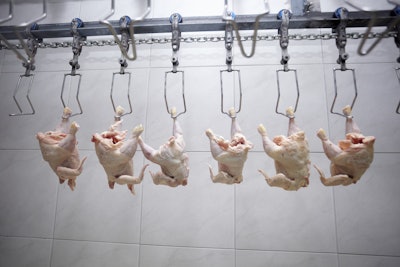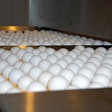
Immersive chilling while the carcass remains on the shackle is not the most common chilling method. However, a new tactic that uses rotational kinematics could lead to a more efficient in-line immersive poultry chilling process. Dr. Comas Haynes, principal research engineer at the Georgia Tech Research Institute, presented the system during the 2021 Poultry Tech Summit Webinar Series on November 11.
How it works
The technology uses optimized rotational patterns and spins the carcasses individually on the shackles while moving through the chill water to help enhance heat transfer from the bird. “We’re never taking the carcasses off the shackles, even during immersive chilling,” stated Haynes. “What we’re finding and confirming is that when you add this additional vector of motion, you’re getting a higher level of relative velocity, even though the line speed has not increased.”
“There is an optimal manner in which to rotate these shackles. This is not just an arbitrary spin,” added Haynes. Agitation research has been done and is continuing to be studied involving the disruption of thermal boundary layers to maximize carcass chilling.
In a study completed in the Fall of 2020, Haynes and his lab studied the relationship between chilling thermal time constant (the time it takes to chill carcasses) and WOG (without giblets) weight. The data showed that when incorporating the rotational kinematics with the line speed in the chiller, time reductions of up to 39% faster, depending on bird size, were observed in the chilling thermal time constant.
“When you get to the chiller, and you’re taking those carcasses off the shackles, you’re taking off some other things as well such as traceability, first in first out and repeatability. Also, you pick up the need for labor intensive rehang after the birds exit the chiller,” added Haynes. Being able to leave carcasses on the shackles during chilling helps answer these questions.
While the dwell time is less compared to the conventional chilling method, there is a question of how this system will affect a plant’s footprint. Haynes explained that there is room for improvement in the reduction of the thermal time constant and further optimization of the rotational patterns. To prevent an increase in footprint, designs for the new chilling system are being based around the typical auger chiller for easy conversion in processing plants as they already exist.
Additionally, the lab’s endeavors are focused on getting rid of compressed air line systems and utilizing the rotational patterns to further chill the birds, instead of hot air bubbles. “We know that this system cannot take up a large footprint, but we are also doing away with the rehang area, which is favorable,” added Haynes.
What’s Next
For more on the technologies set to advance the poultry industry, join industry-changing innovators, researchers, entrepreneurs, technology experts, investors and leading poultry producers at the Poultry Tech Webinar Series, scheduled for November 17, 30 and December 2.
During the webinar series, industry experts will preview what’s coming next – from prospective solutions to developing technology – for the poultry industry.
This webinar series is proudly sponsored by: Arm & Hammer, Aviagen, Baader, Boehringer Ingelheim, Cargill, Ceva, Chore-Time, Cobb, Evonik, Marel, Phibro Animal Health, Staubli, and Zoetis.
Visit our website for more details on the webinar series, topics and speakers.
Register for free today and join us for a glimpse at the future of the poultry industry.


















